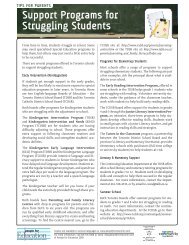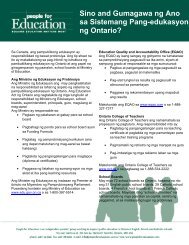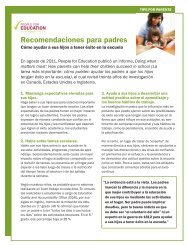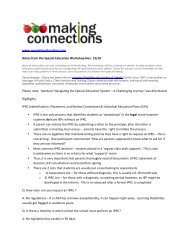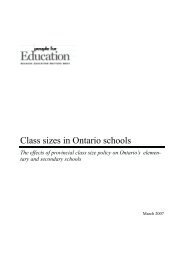Our Children Our Future Our Vision - People for Education
Our Children Our Future Our Vision - People for Education
Our Children Our Future Our Vision - People for Education
Create successful ePaper yourself
Turn your PDF publications into a flip-book with our unique Google optimized e-Paper software.
<strong>Our</strong> <strong>Children</strong>, <strong>Our</strong> <strong>Future</strong>, <strong>Our</strong> <strong>Vision</strong><br />
“Her Majesty agrees to maintain a school in the reserve, allotted to each band, as soon as they<br />
settle on said reserve, and are prepared <strong>for</strong> a teacher.”<br />
(Treaty 4, 1874) 40<br />
“to pay the salary of such teachers to instruct the children of said Indians”<br />
(Treaty 7, 1877) 41<br />
However, the Supreme Court of Canada (SCC) in the Badger and Sundown cases set out several<br />
key treaty interpretive principles that confirm that treaties are not only sacred agreements, but that<br />
they are also an exchange of solemn promises which create mutually binding obligations. 42 They<br />
also held that the honour of the Crown is always at stake when considering the scope and content<br />
of treaties which means that we must assume the Crown always intended to fulfill its promises.<br />
Since the treaties were written by representatives of the Crown, any ambiguities in the words of<br />
the treaty are to be resolved in favour of the Indians. 43<br />
Equally important are the findings of the SCC in Marshall which relied on the decision in Taylor<br />
and Williams to support the proposition that the content of treaties are not determined only by the<br />
specific clauses contained in the treaties, but also by the understanding of the parties at the time<br />
and by the content of treaty negotiation minutes. 44<br />
In my view, the Nova Scotia judgments erred in concluding that the<br />
only en<strong>for</strong>ceable treaty obligations were those set out in the written<br />
document of March 10, 1760, whether construed flexibly (as did<br />
the trial judge) or narrowly (as did the Nova Scotia Court of Appeal).<br />
The findings of fact made by the trial judge taken as a whole demonstrate<br />
that the concept of a disappearing treaty right does justice<br />
neither to the honour of the Crown nor to the reasonable expectations<br />
of the Mi’kmaq people. It is their common intention in 1760 -- not<br />
just the terms of the March 10, 1760 document -- to which effect<br />
must be given. 45<br />
Thus, when considering the treaty right to education <strong>for</strong> First Nations in Ontario, one must look<br />
at more than just a single clause in an individual treaty, but also to the larger context, the understanding<br />
of the parties at the time, and any agreements made outside of treaty document during<br />
40 Ibid. at 129.<br />
41 Ibid.<br />
42 R. v. Badger, [1996] 1 S.C.R. 771 [Badger]. R. v. Sundown, [1999] 393 [Sundown].<br />
43 Ibid. See also: M. Hurley, Parliamentary Research Branch, “Aboriginal and Treaty Rights” (Ottawa: Government of<br />
Canada, 2000), online: < http://dsp-psd.pwgsc.gc.ca/Collection-R/LoPBdP/EB/prb9916-e.htm>.<br />
44 R. v. Marshall, [1999] 3 S.C.R. 456 [Marshall]. R. v. Taylor and Williams (1981), 62 C.C.C. (2d) 227, leave to appeal<br />
refused.<br />
45 Marshall, supra note 44 at para. 40. (emphasis added) See also page 52 where they explained that to do otherwise<br />
would have left the Mi’kmaq with an “empty shell of a treaty promise”.<br />
Chiefs of Ontario<br />
10



